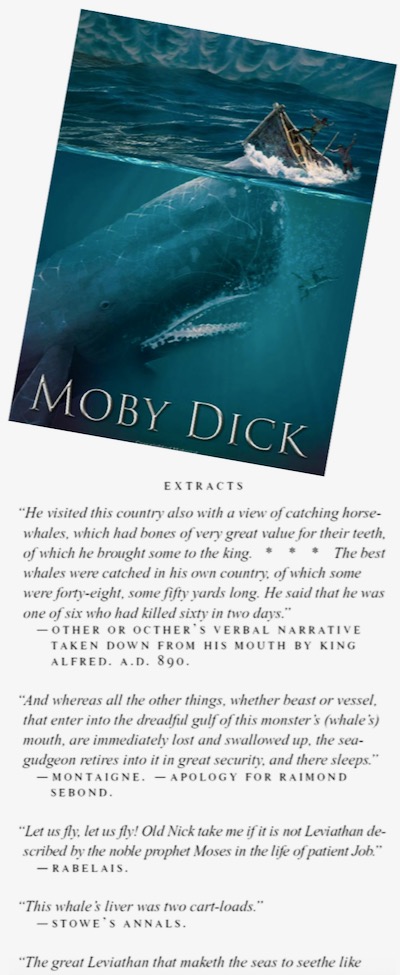10 Reasons We Like Epigraphs in Editing Books for Publication
In preparing our authors’ manuscripts for publishing, we often discuss placing epigraphs at the beginning of each chapter. In our initial conversations with writers, we don’t automatically recommend this style—but in we are finding many authors telling us that they want to use epigraphs.

Extractsat the opening of Herman Melville’s novel, Moby Dick.
Because we are answering so many questions about epigraphs , here’s a helpful column about 10 reasons epigraphs are a smart option.
- Epigraphs demonstrate that an author has done the homework necessary to write with authority. In American literature, the most famous use of epigraphs to achieve this effect is Herman Melville’s Moby Dick, which begins with the author introducing a fictitious librarian who supposedly gathered what he calls
extracts
to start this great novel about whaling. Then, Melville probably sets an epigraphic record by listing 80 of them that spill across page after page. These brief quotes range from passages of scripture—to poetry, journalism and scientific works. Melville is showing us that this novel is truly encyclopedic in its approach to whaling. But 80 epigraphs? In our experience, we have rarely used more than two of them per chapter. - Epigraphs warm readers to the theme and tone for what will follow. A four-word line from Joseph Conrad’s grim novel Heart of Darkness was turned into one of literature’s greatest epigraphs:
Mistah Kurtz—he dead.
The poet T.S. Eliot chose that line from Conrad to open his poem The Hollow Men about the tragic state of humanity following World War I. Starting his poem with those four opening words left no question in the minds of Eliot’s readers that they should brace themselves for a dark journey. - Epigraphs can inspire. By quoting a lengthy passage from the book of Ecclesiastes as an epigraph, Ernest Hemingway signaled to readers of The Sun Also Rises that this particular story about love and loss in 1920s Europe was something far larger—it was part of the timeless struggle of each new generation to survive the scars of the past. The theme of the novel has been hotly debated ever since its publication in . Sometimes, the novel is called
a tale of the Lost Generation,
which of course it was. But, Hemingway disputed that way of summing up his novel. The message was bigger than that, he argued. He pointed to his biblical epigraph and said he believed that even wounded people had a heroic capacity for survival. - Epigraphs may catch the eye of a friend who asks to
take a quick look at that book you are reading
. They are welcoming doorways into your book. Who could resist reading Neil Gaiman’s Coraline after finding the epigraph by G.K. Chesterton:
Fairy tales are more than true: not because they tell us that dragons exist, but because they tell us dragons can be beaten.
- Epigraphs are wonderfully quotable and help your readers spread the news about your book to friends. We’ve all heard someone quote the epigraph from Mario Puzzo’s Godfather:
Behind every great fortune, there is a crime.
- Epigraphs can be counterpoints that provoke, amuse or add an ironic twist to the narrative. We know we’re in for a provocative tale when Ray Bradbury opens Fahrenheit 451 with the epigraph:
If they give you ruled paper—write the other way.
- Epigraphs can be crucial during the editing process in helping a writer to clarify the story’s central theme. When she published To Kill a Mocking Bird in , Harper Lee managed to capture the spirit of the novel in a six-word epigraph from Charles Lamb:
Lawyers, I suppose, were children once.
While editing a book manuscript pre-publication, the selection of epigraphs goes a long way to ensuring that the editor and the writer share the same vision of the book they plan to publish. - Epigraphs fill in the historical context readers need to know, but probably don’t. Rick Atkinson won the Pulitzer Prize for History in for An Army at Dawn, because this history of the Allied armies in North Africa during World War II is so welcoming to readers who know nothing about this vast conflict. He introduces his subject using many elements, including an epigraph. Atkinson opens his book with a helpful locator map and an easy-to-follow chart of the Allied Chain of Command. Then, he drops in an epigraph from Homer’s Iliad to remind readers that war is always as much about earth-shattering tragedy as it is about heroism. By the time they reach Atkinson’s first paragraph, readers have a better sense of the story he is about to relate.
- Epigraphs can connect readers with larger, timely global issues that make a particular new book significant. There is no better example of this, these days, than the passage from Nikolai Gogol’s The Overcoat that opens Jhumpa Lahiri’s novel, The Namesake. The novel is about immigration, family ties and cultural identities in a rapidly changing world. The whole story turns on the characters’ growing awareness:
We all came out of Gogol’s Overcoat.
Putting that reference front and center on the book’s first page signals to readers that the mystery of Gogol’s Overcoat is the key to the novel. - Finally, epigraphs are not old fashioned. They can be as fresh and trendy as the most popular Young Adult titles. If you question this final claim, simply open up your copy of Harry Potter and the Deathly Hallows to find epigraphs that have been read by millions of young people around the world. Who can argue with J.K. Rowling’s success? If epigraphs are good enough for Harry Potter fans—hey, they’re something an author should seriously consider.